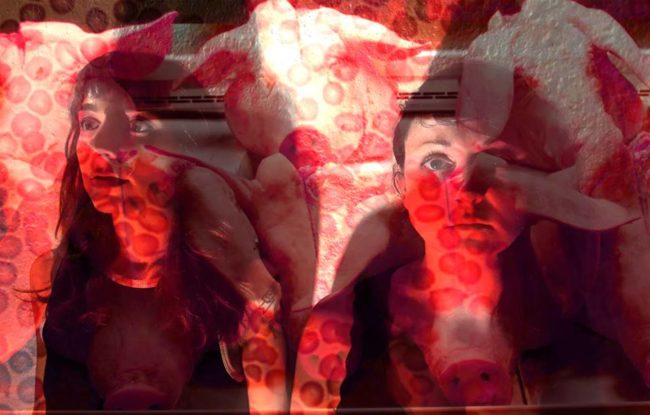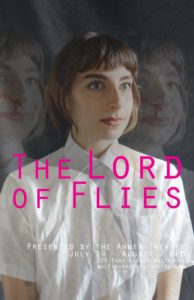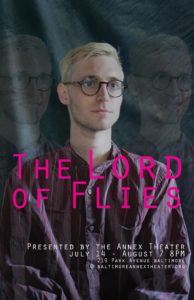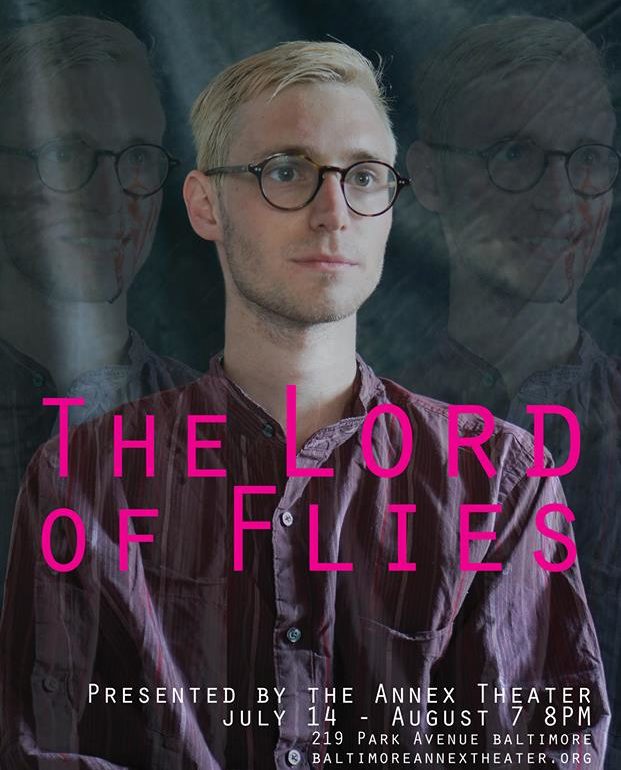Welcome to The Plum Island Infectious Disease Center. In a productive partnership with The Baltimore Annex Theater, resident members of the Plum Island Infectious Disease Center would like to present you with an esteemed press badge, which you will require in order to access the Biosafety Level Four areas of the facility, as an admittance pass to an exclusive three-hour tour. You’ll know what to do when it’s time to do it. Be sure to keep all hands, arms, legs, and other potentially infectable appendages close to your person at all times. They wouldn’t want anyone to turn up missing or misinformed during the tour of the state of the art research facility.
With all the earmarks of an immersive and interactive piece of experimental theatre, Annex Theater’s final offering of their 2015/2016 season is somewhat of a disappointment in that it doesn’t carry further into this territory after teasing the audience so soundly that it will. The Lord of the Flies, as adapted by J. Budenz, M. Coan, S. Jacklin, R. Kidwell, and S. Lamar, is a devised piece of theatrical intrigue featuring a cast and devising team of nine. The misstep with the work here seems to be in marketing it as an adaptation of the infamous novel, which in today’s day and age where so many books and films are adapted to the stage, presents as somewhat of a misnomer; the piece actually feels much more like a brilliantly devised work loosely inspired by and drawing parallels to The Lord of the Flies rather than what an adaptation would imply.

The audience is titillated early on with physical press badges that they’re given to wear, and being introduced to the facility (crafted by Set Designer Rick Gerriets) as members of the press on an exclusive behind-the-scenes tour. But this here ends the audience immersion, other than having members of the cast sit among them from time to time. Gerriets set, however, is remarkably constructed, creating an unsettling verve of sterility mixed with an unnatural sense of confinement. Gerriets’ use of dual-faced platforms allows for ease of scenic transition as well, letting one side serve as laboratory stations and the other function as a blank projection screen for the video projection work of Sonya Norko.
It’s Norko’s videography that sparks the imagination of the audience to suspend our disbelief and let the facility sprawl across the 100 acres upon which it is purported to exist. Norko has several shots of the facility’s doctors traversing corridors and unexplored bits of buildings that ground the play in its setting. But Norko’s most striking work is the colorfully distorted footage used during the ‘coconut crab’ scenes. This pulsating imagery is the perfect backdrop for the narrative that is unfolding around it.
A well-deserved nod must be thrown in Lighting Designer Evan Mortiz’ direction as well for his frightening use of red blinking strobes whenever a quarantine or emergency style alarm blares through the facility. Moritz also highlights each of the absurdly infused dance-breaks with pulsations of green, red, and white, creating a monstrous lightscape of something that vacillates between a living nightmare and a nightmarish reality. While the dance breaks are flawlessly executed— particularly the first one that happens as ‘happy hour’ descends upon the facility— they feel somewhat superfluously inserted to the structure of the performance on the whole. While expressive, Madison Coan’s choreography feels ill-suited to the nature of the show— that is not to say it isn’t fascinating to watch, rather that it just feels out of place. The one instance where this is not true is during the “dance-attack” when Simon cowers at the center of the dance-pit and those dancing around him appear to use interpretive motion here as a nightmare seizing him from the inner workings of his mind.
Vivacious beauty is found in the work of Sound Designer Rjyan Kidwell. There is a hauntingly repetitious exotic musical score that plays upon entry to the facility, lulling the audience into a sense of safety and security with just enough unsettling moments amid the track to keep wonder and mystery as a blatant possibility of the adventure that’s about to get underway. Kidwell delivers a myriad of sound effects throughout the performance, each with their own startling qualities that fit the mood of the moment. Kidwell’s musical selection for the dance breaks seamlessly match the jarring nature of the movements created therein and are some of the more aurally exciting moments of the show.
One of the more brilliant facets of this work is the way in which the cast and devising team addresses time. Paralleling the plot-line of The Lord of the Flies in so much as anarchy starts to reign with terror when an unsupervised group of individuals are meant to govern themselves for an undisclosed and potentially infinite amount of time, minds and concepts therein start to unravel when individuals have lost touch with the controlled environment that they are used to. This lets time move forward without any purchase on reality, which exceptionally captures the notion of how easily one can lose track of time and temporal relationships in a quarantined and isolated situation such as the one these characters find themselves in.
The heightened stakes, the driving fear, the social and political commentary all made by the piece that the nine-person cast has devised is quite intriguing, even if it’s not what is initially expected by the way the it’s presented. A textbook example of how fear can quickly devolve the frightened into ruthless “kill or be killed” animals, The Lord of the Flies leaves you questioning a great deal of things, which readily relate to the current social and political climate of America.
Exceptional performances comes from the entirety of the cast, but those expressly worth praising include the Doctors Eriksem (Dave Iden and Maddy Scott.) This nerdy pair of shyly awkward and awkwardly shy individuals are precious in their meekness, particularly in Iden’s physical inwardness, drawing himself with gestures of someone who is truly introverted. The pair play well off one another, particularly when thinking and then speaking as one, and show up late in the show with some of the most striking makeup effects witnessed in the production.

Playing the polar opposites of these two, Jackie (Madison Coan) and Dr. Wolfe (Sarah Jacklin) are the hyper-actualized extroverts, who are constantly at each other’s throats, first verbally and later physically. Watching Coan and Jacklin build tensions between themselves and the overall circumstantial situation in which they find themselves is brutally delicious, particularly when they individually strike out and attempt to take hold of the group’s leadership. Both Coan and Jacklin have tremendous gusto when it comes to stage presence and know how to balance their emotions with their volume so that not every intense emotion is delivered at the peak of their vocal capacity.
Starting off at the coolly composed group guide, Portia (Sarah Lamar) is unwavering in her plastic and polished demeanor, right up until she isn’t. Lamar builds up quite the show of restraint with her character, making the pending moment of her emotional explosion that much more desperate, each subtle scuffle which she attempts not to engage in adding one more combustible log to an already smoldering fire. When Lamar hits that point it is deeply rewarding to watch her character go soaring off the rails of a fury train, and there is a blessed catharsis blazing before the audience’s eyes that might be one of the most rewarding moments of the show because of the way she’s built up to its eruption.

Presenting a refreshing alternative to hot tempers, explosive shouting, and all things driven wild by fear, Jacob Budenz gives a delectable performance as Simon the veterinary sphynx. Completely captivating the audience with his tragically beautiful tale of the coconut crabs on Giant Island, Budenz mesmerizes and even hypnotizes a sense of comfort when all else around is calamity and chaos. Entwined in the anecdotal saga, Budenz narrates the tale in a calming and soothing tone while still perfectly articulating the darker and gruesomely grim meaning of the story. Budenz’ character affectations of delicately set back in its own little animal-empathy bubble is sweet and the perfect balance to all of the volatile temperaments that are in perpetual flare-ups throughout the show.
A performance that drives questions, presents thoughts that would otherwise remain undiscussed, and prods the mind with curiosities, The Lord of the Flies, as a devised work, is something to take in and marvel over, and then flee from with those thoughts and questions ready for debate upon the present-day tongue.
Running Time: Approximately 75 minutes with no intermission
The Lord of the Flies plays through August 7, 2016 at Annex Theater— 219 Park Avenue in Baltimore, MD. Tickets may be purchased at the door or in advance online.

